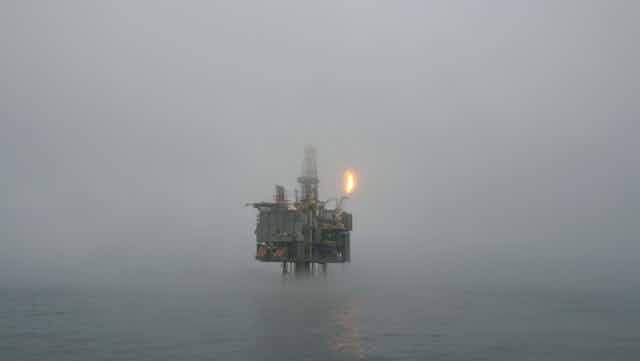A large oil find has been declared 60 miles west of Shetland, off the north coast of Scotland. It’s being described as the UK’s “largest undeveloped discovery”. Taken at face value, this is exciting news for an industry still reeling after the oil price collapse of the past few years (environmentalists though are less enthusiastic).
The discovery was made by Hurricane Energy, a specialist exploration firm, which announced that its Halifax well had found large amounts of oil. It said it had also successfully undertaken a production test in which oil flowed at an impressive rate. This find may even be connected with a previous discovery nearby (the Lancaster field) and hence be part of one large accumulation of nearly a billion untapped barrels.
Hurricane Energy specialises in trying to extract oil from so-called fractured “basement” reservoirs. While most oil, including most North Sea oil, is found within sedimentary rocks such as sandstone, these basements occur when oil gathers in the natural cracks (or fractures) between impermeable igneous rock. In this specific case, Hurricane was actively searching along the Rona Ridge – a prominent seabed feature which hosts several oil fields.
This is undoubtedly an encouraging result for the UK oil industry as it seeks to extend the life of a mature basin characterised by ever diminishing resources. However, it is important to underline that there are major geological hurdles still to overcome and the oil can’t yet be considered potential, probable or proven reserves, all of which have strict statistical and commercial definitions.

Although fractured reservoirs have been successful elsewhere in the world, most notably in Vietnam and Yemen, this would be a first in the UK. The rocks around Shetland are very dense, and it’s particularly hard to work out how much oil is found in the narrow, open fractures in between them.
Success is likely then to be dependent on the fractures, which not only need to be significant but also suitably oriented for a directional drill bit to intersect them. Fractured basements are notorious for fast depletion on production as the fractures are drained quickly, and such fields consequently commonly have a shorter shelf life.
It is also worth remembering that no basement has been shown to work elsewhere in the North Sea to date. Concerns over economic viability mean the most notable discoveries at Cairngorm and at Bagpuss have yet to be developed. Hurricane will need to conduct an extended well test to demonstrate sufficient flow for the field to be feasible in the long term. Also, more drilling will probably be required to ascertain whether the Halifax oil exists in one large reservoir or in several smaller accumulations. The latter is much harder to develop.
Oil type
The billion barrels quoted in the media is certainly an eye-watering discovery – especially now, after oil firms have been scouring the North Sea for decades. However it is unclear whether these are actual usable resources. Given what we know about this field and the typical recovery rates of oil from fractured reservoirs, actual reserves may be around 200m barrels – reasonably large but not especially so (the largest oil fields in the Gulf have tens of billions of barrels).
We also don’t yet know what sort of oil has been found. Oil in nearby Clair Field is particularly viscous and heavy, which meant it was left in the ground for almost 20 years until better technology and higher prices made extracting it worthwhile. If the Lancaster/Halifax oil has similar characteristics the operator will face additional challenges.
A long way to go
Even presupposing that the geology, oil type and drilling can lead to a successful development, it seems likely that evacuation would have to take place by hooking up the discovery with existing pipeline infrastructure or a Floating Production Storage and Offloading (FPSO) facility.

However, with the infrastructure that is now in place and with the experience major operators have gained in developing their oilfields west of Shetland with few incidents, the development of another large field nearby should not prove to be a major hurdle.
This discovery raises various social and political questions, of course. After Brexit, is this the UK’s oil or Scotland’s, or even Shetland’s? Do people want the jobs, income and secure energy supply that comes from a thriving offshore industry, or would they instead highlight the global carbon budget and choose to leave that oil under the sea?
Who knows? What we can say, as petroleum geoscientists, is that we are excited but cautious. After all, it took more than 28 years from Clair’s initial discovery for its reserves to be confirmed.

